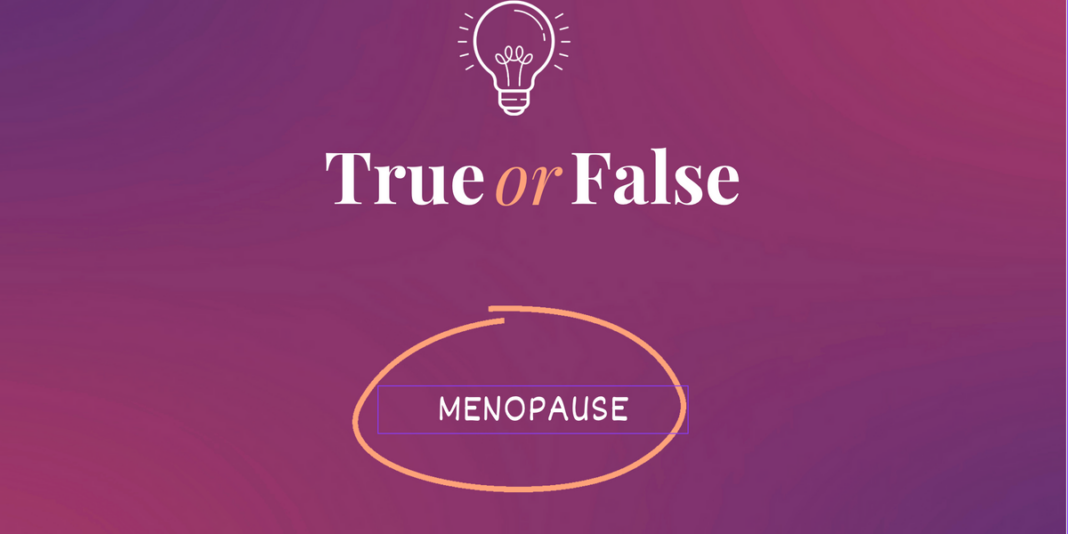
October 18, 2024, is World Menopause Day.
Menopause is a natural part of life that everyone who menstruates will go through at some point.
But if you feel self-conscious talking about menopause — we hear you. Despite the fact that more than half of the population experiences this change, there’s still stigma and disparities in education about all the different ways menopause can affect your body, mind and everyday life.
So, let’s pause here for a second so you can take our quiz (see what we did there?) and see how much you know about the signs, symptoms and important facts about menopause.
1. Menopause is the time in your life when you stop having periods.
[shortcode-true-false-quiz answer=”true” description=”Although menopause involves a lot more than just periods — or the lack thereof — a woman has reached menopause when she hasn’t had a period for 12 straight months. This happens when your ovaries stop making estrogen — the hormone that helps control menstrual cycles. number=”1″]
2. The years leading up to menopause are called perimenopause.
[shortcode-true-false-quiz answer=”true” description=”Perimenopause is the time before menopause when your estrogen and progesterone levels start to fluctuate. Most women are in perimenopause for an average of seven years but perimenopause can go on for more than 14 years. Race, ethnicity and lifestyle factors such as smoking can influence how long you’re in perimenopause. number=”2″]
3. The average age of menopause is 50.
[shortcode-true-false-quiz answer=”false” description=”But if you thought 50 was true — you’re not far off. On average, menopause happens at 51. People typically start perimenopause, the menopause transition, between ages 45 and 55. number=”3″]
4. Vasomotor symptoms — hot flashes and night sweats — start after menopause.
5. There are four stages of menopause.
6. You can get pregnant during the menopause transition.
[shortcode-true-false-quiz answer=”true” description=”If it’s been less than 12 months since your last period and you don’t want to get pregnant, you should still use birth control. But a year without a period means you’ve hit menopause and your ovaries have stopped releasing eggs. It’s important to note that you can’t get pregnant naturally after menopause, but you can still get a sexually transmitted infection if you have unprotected sex. So, make sure you’re protecting yourself before, during and after menopause. number=”6″]
7. You can take a menopause test.
[shortcode-true-false-quiz answer=”true” description=”Healthcare providers can test levels of certain hormones, like follicle stimulating hormone (FSH) and estradiol or others, to see if a person is in menopause. You don’t need to test for all hormones, and these hormones are just some examples of what you can test for. There are also at-home kits that can test the level of some of these hormones in your pee to help determine what possible stage of menopause you’re in, although most people rely on the signs and symptoms to confirm menopause. number=”7″]
8. Menopause weight gain is the most common symptom associated with menopause.
[shortcode-true-false-quiz answer=”false” description=”Healthcare providers can test levels of certain hormones, like follicle stimulating hormone (FSH) and estradiol or others, to see if a person is in menopause. You don’t need to test for all hormones, and these hormones are just some examples of what you can test for. There are also at-home kits that can test the level of some of these hormones in your pee to help determine what possible stage of menopause you’re in, although most people rely on the signs and symptoms to confirm menopause. number=”8″]
9. Hormone therapy is the only way to treat menopause symptoms.
[shortcode-true-false-quiz answer=”false” description=”Hormone therapy is just one option to help treat symptoms associated with menopause. Hormone therapy works by adding estrogen, progesterone or both back into the body through prescription pills, patches or cream. Other treatments include non-hormonal medications, antidepressants, cognitive behavioral therapy and lifestyle changes such as exercise and eating a balanced diet. number=”9″]
10. The loss of estrogen during menopause means a lower risk for cardiovascular disease.
[shortcode-true-false-quiz answer=”false” description=”Estrogen helps keep blood vessels relaxed and open, and a lack of estrogen can allow cholesterol to build up in the arteries, which can increase the risk of heart disease — the number one killer of women in the U.S. Thankfully, there are things you can do to help prevent heart disease at any age, including eating a healthy diet rich in fruit, vegetables and whole grains; getting enough physical activity, and taking any medications you’ve been prescribed for blood pressure, cholesterol and diabetes. number=”10″]
This educational resource was created with support from Astellas, a HealthyWomen Corporate Advisory Council member.
From Your Site Articles
Related Articles Around the Web




